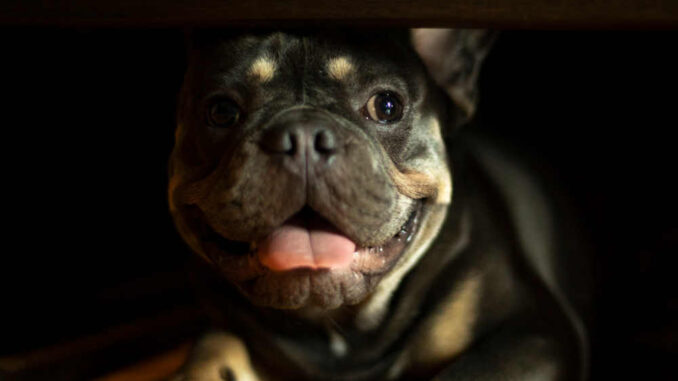
This article was updated on September 3rd, 2023
Many pet parents are understandably concerned when their dog starts panting at night. So, if you’ve found yourself wondering “why is my dog panting at night, and is it normal?” you’ve come to the right place. This article will discuss the most common reasons for nighttime panting and what you can do to help your furry friend.
If your dog is senior – about 8 years old or older – read our article about senior dogs panting at night which will address reasons specific to older dogs. If your dog is younger, read on!
What’s Considered Abnormal Dog Panting?
Panting is important to help regulate your pup’s body temperature in hot weather or after exercise and is the major method of evaporative cooling in dogs.[1] Your dog’s normal respiratory rate is 15-30 breaths per minute (when at rest or asleep), but panting can be up to 10 times faster – around 300 breaths per minute!
Though panting is a natural response to help our pups keep cool, there are times when panting is abnormal and may be cause for concern, including:
- Panting without an obvious reason, such as warm weather, exercise, excitement/stimulation, or a stressful situation.
- Panting accompanied by abnormal breath sounds, such as breathing louder than normal.
- Difficulty breathing and pale or blue-colored gums.
- Struggling to exercise normally or panting more than usual.
- Panting accompanied by pain or other signs of illness, such as vomiting or diarrhea.
Is My Dog’s Panting Serious?
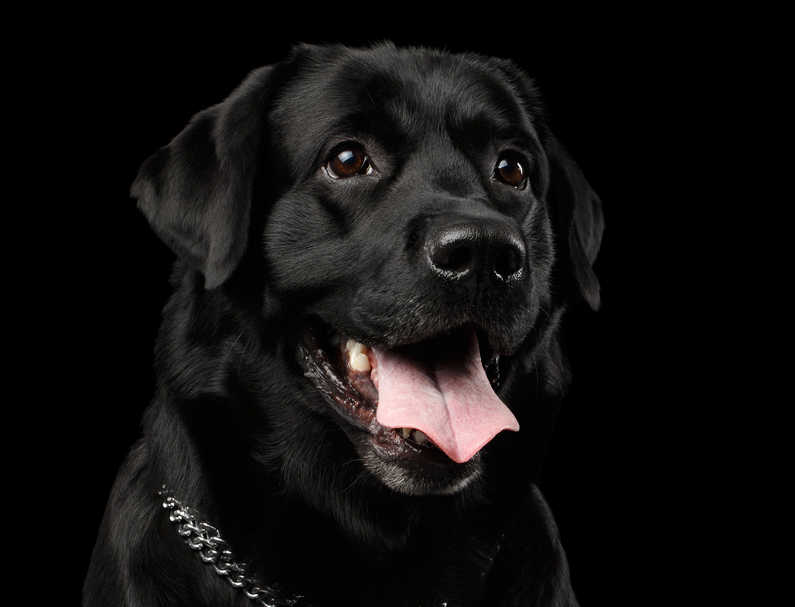
Panting is a completely normal response to help your pup regulate their body temperature but it can also be associated with several serious diseases, including heatstroke and heart disease. This is why it’s important to be able to recognize the difference between normal and abnormal panting and to seek urgent veterinary attention if you have any concerns about your dog’s breathing.
4 Most Common Reasons Causing Dogs to Pant at Night
Your pup’s environment may be a little bit warm and they are simply panting to try and cool themselves down. You might also notice that your dog is laying stretched out on a cool surface, like a tiled floor, or that they are a little bit restless. It is important, however, to be able to differentiate between normal heat exchange, where your dog is comfortably able to regulate his temperature, and heatstroke (see below).
1. Pain
Dogs experiencing pain for any reason may also pant at night due to an increase in stress hormones (e.g., cortisol). Changes to your dog’s behavior when in pain can be subtle, such as limping, stiffness, poor appetite, changes in posture and attitude (more withdrawn or irritable), and they won’t always cry out or vocalize as many pet parents expect.[2] Many causes of pain, such as osteoarthritis, can be managed with pain medications and supportive therapies like physiotherapy, but it’s important that the cause of the pain is correctly diagnosed so it can be treated effectively
2. Stress or anxiety
Your dog may also pant at night in response to a stressful situation or due to anxiety. Loud noises, like thunderstorms or fireworks, in particular, can cause a great deal of stress and your pup may also start shaking, pacing, vocalizing, and trying to hide or escape.
If you are concerned that your dog may be having difficulty coping with stress or anxiety, it’s always best to speak to a veterinarian or a specialist in veterinary behavior who can help formulate a treatment plan. This may include sound desensitization for noise sensitivity, creating a calm environment, positive training techniques, and the use of supplements or medications.
3. Age
Many pet parents notice their senior dog panting at night. As older dogs are more likely to suffer from medical problems such as heart disease, or experience chronic pain from osteoarthritis, nighttime panting should always be investigated by a veterinarian.
Senior dogs may also experience Canine Cognitive Dysfunction, a condition similar to dementia in humans, that can result in distress, panting, and pacing at nighttime. Sadly, there is no cure for this condition, but there are medications and supplements that may be helpful and your veterinarian will also be able to provide advice on how best to support your senior dog during this time. If your dog is a senior dog (7-8 years old or older), read our article: 6 Reasons Old Dogs Start Panting at Night.
4. Disease-related panting
Heatstroke
In warm environments (including hot cars, direct sunlight, and when exercising in warm weather), heatstroke may occur if your dog’s body temperature continues to rise, despite their best efforts to cool down. Dogs that are overweight, have thick coats (e.g., Huskies and Alaskan Malamutes), or are brachycephalic (flat-faced, e.g., pugs, bulldogs) tend to be more sensitive to heatstroke. Signs of heatstroke in dogs include:
- Panting, heavy breathing, or difficulty breathing
- Lethargy
- Confusion or disorientation
- Bright-red gums or tongue
- Foaming at the mouth
- Weakness
- Shaking
- Collapse
- Vomiting or diarrhea
- Seizures, coma, and death in severe cases
If you suspect your dog may be suffering from heatstroke, the best thing you can do is take them immediately to the nearest emergency veterinarian. Heatstroke is often fatal if left untreated and the sooner your pup receives veterinary care, the better their chances of recovery.
Heart disease
Dogs suffering from heart failure experience a build-up of fluid in their lungs. This can cause panting, coughing, exercise intolerance, and an increased respiratory rate when sleeping or resting (more than 30 breaths per minute). Though heart failure cannot be cured, there are medications available to help reduce fluid build-up and improve your dog’s quality of life. Learn more about heart disease in senior dogs.
Cushing’s Disease
This is a condition where the adrenal glands produce excessive levels of certain hormones, including cortisol. Dogs with Cushing’s Disease may experience panting, increases in thirst, appetite, and urination, as well as a pot-bellied appearance, lethargy, and changes to the skin and coat. Treatment options for Cushing’s Disease commonly include long-term medications but can also include surgery to remove an adrenal tumor if this is the underlying cause. View pictures of dogs with Cushing’s disease and advice from our veterinarians.
Respiratory disease
Diseases affecting the airways and lungs, such as pneumonia, laryngeal paralysis, or tumors, may also cause nighttime panting. Your dog may also cough, retch, make unusual breathing sounds (e.g., snoring, snorting, wheezing), and experience difficulty exercising. Being overweight can also exacerbate respiratory problems, and is just one of the many reasons for ensuring your dog maintains a healthy body weight.
Brachycephalic breeds are also prone to panting and abnormal respiratory sounds such as snoring or snorting due to their airway conformation. Certain individuals will be more severely affected by Brachycephalic Obstructive Airway Syndrome (BOAS) and may require surgery to help them breathe more comfortably.
Steps To Take At Home to Help Your Dog – Our Veterinarian’s Tips
If your dog is panting at night, here’s a helpful list of steps you can take:
1. Check your dog carefully – emergency triage
Assess your dog’s behavior and check them over for signs of heatstroke. If you think your dog may have a heatstroke or is struggling to breathe, the best thing to do is take them immediately to the nearest emergency veterinarian. In cases of heatstroke, it can be helpful to offer your dog water on the way, wet their fur, and use the fan in the car to help keep them cool.
2. Check the environmental temperature
If your dog’s environment is too warm, try offering them a cool drink of water, keeping them indoors with access to a fan or air-conditioning, using cooling mats, or wetting their fur as needed. Your dog’s panting should stop once they reach a comfortable temperature, and if it doesn’t, consider the possibility of heatstroke and seek urgent veterinary attention.
3. Book in a vet check
If your pup is panting at night, it’s always best to have them checked over to rule out a medical problem. This will also be beneficial if the behavior is related to stress, anxiety, or brain-aging (Canine Cognitive Dysfunction) in older dogs. Certain medications such as corticosteroids (e.g., prednisone/prednisolone) may also cause panting,[3] and your veterinarian will be able to discuss any possible side effects with you.
4. Create a calming environment
If your dog is panting but otherwise seems comfortable you can try offering a cool drink of water and reassuring them using soothing tones to help them relax. Make sure their environment is cool and calm (free from other pets and distractions). In cases of a fireworks phobia, close the blinds, create a den or safe space for hiding, and turn on the TV or background music.
5. Consider pheromones and supplements
If your pup’s nighttime panting is related to stress or anxiety, calming supplements, pheromone diffusers, and sprays can be helpful when used alongside a behavior modification plan. Supplements may also help senior dogs with Canine Cognitive Dysfunction. Be sure to ask your veterinarian for a recommendation for clinically-proven products that are safe for dogs.
When Is It Time To See the Vet?
If your dog is showing signs of distress, difficulty breathing, has pale or blue-tinged gums, pain, or any of the signs associated with heatstroke, they need to see an emergency veterinarian immediately. Even if you aren’t sure, it’s always better to be safe than sorry as any issue affecting your dog’s breathing could be life-threatening.
Unless your dog’s nighttime panting is related to heat exchange and stopped when you turned on their air conditioner or a fan, all cases of nighttime panting should warrant a trip to the veterinary clinic for further investigation to rule out an underlying medical or behavior problem.
Learn more about panting in dogs from our veterinarians
References
[1] Goldberg, M & Langman, VA, 1981, Panting in dogs: Paths of air flow in response to heat and exercise, Respiration Physiology, 43(3), pp: 327-238
[2] WSAVA, 2014, Guidelines For Recognition, Assessment And Treatment Of Pain, Available at: https://wsava.org/wp-content/uploads/2020/01/Recognition-Assessment-and-Treatment-of-Pain-Guidelines.pdf, Accessed: 26 January 2022
[3] Elkholly, DA, Brodbelt, DC, et al., 2020, Side effects to systemic glucocorticoid therapy in dogs under primary veterinary care in the UK, Front Vet Sci., 7, pp: 515
Disclaimer: This website's content is not a substitute for veterinary care. Always consult with your veterinarian for healthcare decisions. Read More.


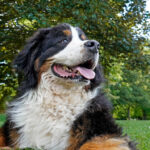
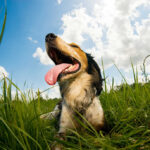
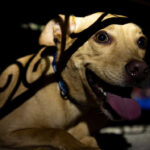
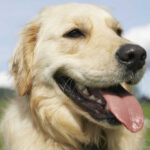
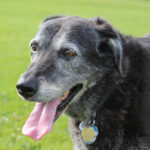
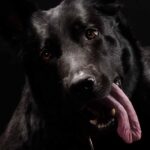
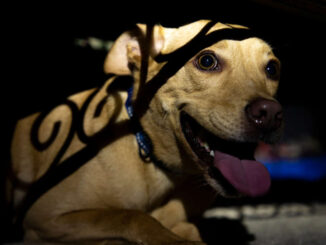
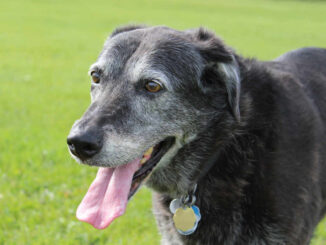
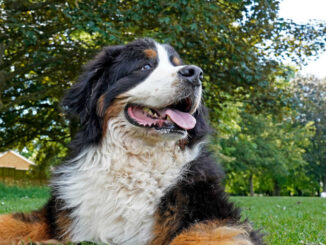
Be the first to comment